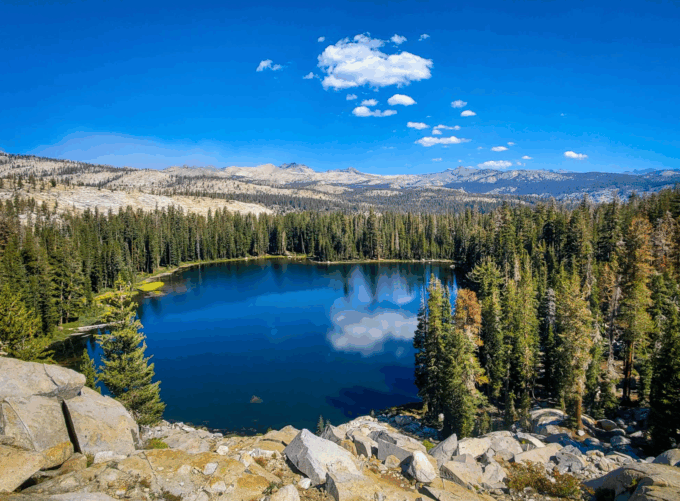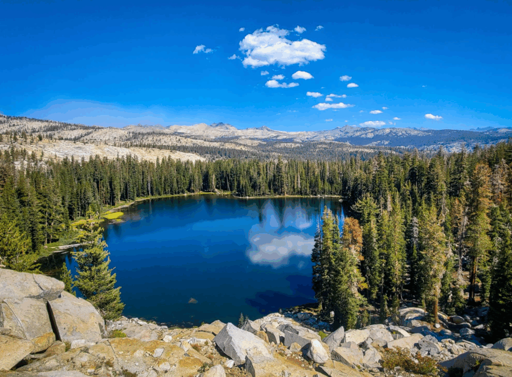
Ansel Adams Wilderness by René Voss.
Moved by the radiance of sunbursts bouncing between granite peaks, John Muir once called the Sierras the “Range of Light.” Now, a century later, millions of acres of Wilderness and wild forest in the Range of Light are under threat of reckless cutting and incineration at the hands of those tasked with guarding them. Threatened and endangered wildlife like the spotted owl, wolverine, and Pacific fisher are facing displacement and death based on shoddy fire science and manufactured panic surrounding wildfire and the climate crisis. The nexus of ecological crises that we live under are being weaponized to fuel misguided fear of fire and justify bloated wildfire budgets. The Sierra and Sequoia Prescribed Burn Project encapsulates the agencies’ endgame—Wilderness where nothing is wild and no fires burn unless the agency lights them. How did we get here, and how do we liberate Wilderness from the hands of its “stewards?”
In May of this year, the Forest Service released a draft decision, bringing them closer to thinning and burning up to 2.4 million acres of national forest in California’s High Sierra, including 800,000 acres across eleven Wildernesses including the Ansel Adams, Monarch, Golden Trout, Jennie Lakes, and John Muir Wildernesses. The Sierra and Sequoia Prescribed Burn Project would move forward in 5-year increments, seemingly in perpetuity, with no further opportunity for public comment. This burning and thinning would include chainsaw and helicopter use throughout Wilderness, as well as drones dropping incendiary devices and setting the forests ablaze. The project would mark a new and unprecedented era of human manipulation of Wilderness.
In 2022, the government spent over $6 billion on wildland fire management, with more than half of that going towards suppression. For years, this allocation of funding led to the damaging practice of “fire borrowing,” in which funds were diverted from other Forest Service programs to cover suppression costs. While a 2018 law largely ended this practice, the financial pressure it created left the agency vulnerable to new priorities, and the fix is set to expire in 2027. The Forest Service has to justify its budget in reports highlighting actions in terms of fires suppressed and acres treated. It is action for the sake of action, which is antithetical to the idea of Wilderness.
The Sierra and Sequoia Prescribed Burn Project is only the latest in a long line of projects that land management agencies have tried to push through under the umbrella of “conditions-based management” or CBM. Under the CBM approach, the Forest Service proposed a massive project area through a single environmental assessment, rather than a more robust environmental impact statement, foregoing any additional opportunity for public input. While the agencies claim that CBM is not a “get-out-of-NEPA-free card,” in reality this is exactly what CBM is. How else can one characterize a project that will continue into the future, seemingly forever, across 2.4 million acres, without any further opportunity for public input?
The agencies have created an internal system for wilderness management which pits elements of wilderness character against one another, justifying the trammelling of Wilderness using motorized tools and helicopters to “restore” Wilderness to a desired state of naturalness. But what does naturalness mean and how do you define it, especially in the age of perpetual and omnipresent human impacts? There is a fundamental contradiction in coercing Wilderness into naturalness—it is, by the very act of coercion, unnatural. Under the Burn Project, the Forest Service proposes to strong-arm Wilderness into a pre-global warming “desired condition” of naturalness, while in the midst of an ongoing climate crisis. At the end of the day, the agencies are simply using the idea of naturalness to justify any and all projects they wish to carry out for the sake of appeasing politicians and imposing managers’ desired conditions on the landscape.
Ironically, the Forest Service attempts to justify ecosystem-level manipulation of Wilderness by pointing to the nebulous boogeyman of climate change. I’m no climatologist, but my understanding of climate change is that it’s expected to get worse. Our models are increasingly unreliable because they are based on a planet that no longer exists. If at any moment you are adjusting your management approach to current climate conditions, your baseline will be out-of-date in a few short years. Unless the Forest Service has a crystal ball, or better climate modeling than anything we’ve seen up to this point, managing for climate change is like shooting at a target that’s not only moving, it’s invisible.
It is argued that in the anthropocene nothing exists beyond the thrall of human impacts, including Wilderness. Perhaps, but there must be spaces where we simply observe how the land adapts to climate change, while humanity tries to get its act together outside these small, important places. This understanding of Wilderness, as a control used to measure scientific research and management strategies, was highlighted repeatedly in the congressional records leading up to the passage of the Wilderness Act in 1964; “The Bill sets up areas which can be used as yardsticks,” and Wilderness is “of irreplaceable value to science as sites for fundamental research and as check areas where none of the human factors being compared by investigators have been operative.” Aldo Leopold himself said, “A science of land health needs… a base datum of normality, a picture of how healthy land maintains itself as an organism…the most perfect norm is wilderness.”
The Wilderness Act was not an attempt at returning to some idyllic, pristine past—it is a forward-thinking document that sought to minimize human impacts on these lands from the moment of their designation on, creating living, breathing, experiential textbooks that can teach us about evolution and adaptation—but we have to let them. All the while, the Forest Service shows no sign of letting up in its culture of large-scale fire suppression. It seems the ideal world for managers is one in which no fires happen unless they are the ones setting them, completely eradicating the wild from wildfire and Wilderness.
All of these factors have created the circumstances under which a project like the Sierra and Sequoia Prescribed Burn Project could exist, ultimately culminating in a full-on attack on wild nature and the defining character of Wilderness: its wildness. We are all bothered when the agencies disregard the ban on motorized equipment by using chainsaws and helicopters rather than non-motorized tools, and Wilderness Watch will do everything we can to prevent it, but this presents a new paradigm in which agencies can throttle Wilderness through endless ecosystem-level manipulation. It is more than a violation of the Wilderness Act, it is an attempt to tame the essence of Wilderness.
The post Torching the “Range of Light” appeared first on CounterPunch.org.
From CounterPunch.org via this RSS feed


